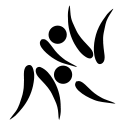Alessandra Giungi
| Data i miejsce urodzenia | ||||||||||||||||||||||||||||||||||||||||||||||
|---|---|---|---|---|---|---|---|---|---|---|---|---|---|---|---|---|---|---|---|---|---|---|---|---|---|---|---|---|---|---|---|---|---|---|---|---|---|---|---|---|---|---|---|---|---|---|
| Wzrost | 169 cm | |||||||||||||||||||||||||||||||||||||||||||||
| Dorobek medalowy | ||||||||||||||||||||||||||||||||||||||||||||||
| ||||||||||||||||||||||||||||||||||||||||||||||
Alessandra Giungi (ur. 5 maja 1966) – włoska judoczka[1]. Trzykrotna olimpijka[2]. Zajęła piąte miejsce w Barcelonie 1992[3] i dziewiąte w Atlancie 1996[4]. Trzecia w turnieju pokazowym w Seulu 1988. Startowała wadze półlekkiej.
Mistrzyni świata w 1991, druga w 1989 i trzecia w 1987. Brała udział w zawodach w 1984, 1986, 1993 i 1995. Startowała w Pucharze Świata w latach 1989, 1992, 1993, 1995, 1996[5]. Zdobyła dziewięć medali na mistrzostwach Europy w latach 1987 – 1996[6] roku.
Letnie Igrzyska Olimpijskie 1988
| Konkurencja | Eliminacje | Finały | Klas. końcowa |
|---|---|---|---|
| Przeciwnik I | 1/2 | Miejsce | |
| 52 kg[7] | Z | P | 3. |
Letnie Igrzyska Olimpijskie 1992
| Konkurencja | Eliminacje | Repasaże | Klas. końcowa | ||||
|---|---|---|---|---|---|---|---|
| Przeciwnik I | Przeciwnik II | Przeciwnik III | Przeciwnik I | Przeciwnik II | Przeciwnik III | Miejsce | |
| 52 kg[8] | Z | Z | P | Z | Z | P | 5. |
Letnie Igrzyska Olimpijskie 1996
| Konkurencja | Eliminacje | Repasaże | Klas. końcowa | |
|---|---|---|---|---|
| Przeciwnik I | Przeciwnik I | Przeciwnik II | Miejsce | |
| 52 kg[9] | P | Z | P | 9. |
Przypisy
- ↑ Alessandra Giungi Biography and Olympic Results, Sports-Reference.com [dostęp 2020-06-15] [zarchiwizowane z adresu 2018-10-03] (ang.).
- ↑ Athletes, Olympic.org [dostęp 2020-06-15] (ang.).
- ↑ Judo at the 1992 Barcelona Summer Games:Women's Half-Lightweight, Sports-Reference.com [dostęp 2020-06-15] [zarchiwizowane z adresu 2018-10-03] (ang.).
- ↑ Judo at the 1996 Atlanta Summer Games:Women's Half-Lightweight, Sports-Reference.com [dostęp 2020-06-15] [zarchiwizowane z adresu 2019-04-19] (ang.).
- ↑ Alessandra Giungi Judoka, Judoinside.com [dostęp 2020-06-15] (ang.).
- ↑ Alessandra Giungi Judoka, Judoinside.com [dostęp 2020-06-15] (ang.).
- ↑ Head-to-heads, Ijf.org [dostęp 2020-06-15] (ang.).
- ↑ Head-to-heads, Ijf.org [dostęp 2020-06-15] (ang.).
- ↑ Head-to-heads, Ijf.org [dostęp 2020-06-15] (ang.).
Media użyte na tej stronie
Pictograms of Olympic sports - Judo. This is unofficial sample picture. Images of official Olympic pictograms for the 1948 Summer Olympics and all Summer Olympics since 1964 can be found in corresponding Official Reports.
Flag of Portugal, created by Columbano Bordalo Pinheiro (1857-1929), officially adopted by Portuguese government in June 30th 1911 (in use since about November 1910). Color shades matching the RGB values officially reccomended here. (PMS values should be used for direct ink or textile; CMYK for 4-color offset printing on paper; this is an image for screen display, RGB should be used.)
Chinese Taipei Olympic Flag. According to the official website of Chinese Taipei Olympic Committee, Blue Sky(circle) & White Sun(triangles) above the Olympic rings is neither the National Emblem of the Republic of China, nor the Party Emblem of Kuomintang (KMT), but a design in between, where the triangles do not extend to the edge of the blue circle, as registered at International Olympic Committee in 1981 and digitally rendered in 2013. Besides, the blue outline of the five-petaled plum blossom is broader than the red one. Moreover, the CMYK code of the blue one and the Blue Sky & White Sun is "C100-M100-Y0-K0", and different from the Olympic rings (C100-M25-Y0-K0). Note that it's the only version recognized by IOC.












